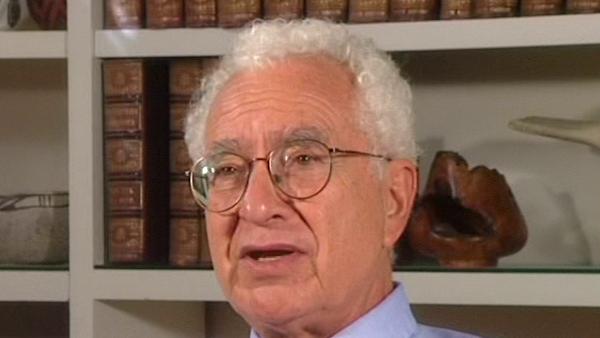NEXT STORY

Testing superstring theory
RELATED STORIES

NEXT STORY

Testing superstring theory
RELATED STORIES


|
Views | Duration | |
|---|---|---|---|
| 151. The fourth quark | 629 | 03:16 | |
| 152. Salam and Ward | 1241 | 01:18 | |
| 153. Sheldon Glashow; enemy of superstring theory | 1599 | 01:55 | |
| 154. Crucial tests for string theory | 903 | 01:03 | |
| 155. Superstring theory | 908 | 03:32 | |
| 156. Testing superstring theory | 1130 | 03:27 | |
| 157. Calculating the probability of possible solutions for the universe | 585 | 01:34 | |
| 158. Boundary conditions in the context of string theory | 494 | 01:09 | |
| 159. Cosmology, astrophysics and particle physics | 625 | 03:56 | |
| 160. Working on quantum mechanics, the work of Everett | 1185 | 03:01 |


Superstring theory seems to have the right properties to be the long-desired unified quantum field theory of all the particles and all the forces. Of course it's not a theory of everything because to describe reality you need not only the theory of the particles and forces; you also need the initial condition of the universe near the beginning of its expansion. And also the results of an unimaginably long sequence of chance events that also determine the history of the universe… co-determine the history of the universe along with the… along with the two fundamental laws. Hopefully we can discuss that… later. Surely. But… but as the fundamental theory of the particles and forces it seems quite a… it is the only candidate and it seems very promising. Recent developments in theory have removed some of the apparent ugliness that was there because there were several forms of superstring theory: type 2A, type 2B and different groups and so on and so forth. But it seems plausible now, as a result of the duality demonstrations… the recent demonstrations of duality, it seems plausible that all the different theories, as they were called, are just different phases of a single theory. And the many solutions that people seem to have found, at least approximate solutions, if they are genuinely exact solutions, they would also most likely be different phases. So there's really just a single theory, and it would be the only manifestation of the bootstrap idea. Well that's very beautiful, and the bootstrap idea of course can be explained very easily in words, which is something that many people wanted as a characteristic of the... of the unified theory. The… the fact that in the suitable approximation it predicts Einstein's general relativistic theory of gravitation, it incorporates it into quantum mechanics without encountering any infinities, is wonderful. So I'm very strongly in favor of the possibility that it might be the right fundamental theory, or at least would develop into the right one. We've seen with these latest researches and the change of name from superstring theory to M-theory, that one can discover more properties in the theory and it then assumes a somewhat different shape from what one had previously assumed, but it should be… should be regarded still as the same theory. It seems to have other sectors: the latest fashion, they say, is to describe the so-called base space as a one-dimensional space with just the tau variable, not sigma and tau, then in that base space one can have supersymmetry all the way up to M = 16. And that would be the chosen one, the maximum… maximum number of supersymmetries that one can have with one base space dimension. It all sounds very exciting to me. Of course, I'm not following it in detail; I'm following it like a reporter.
New York-born physicist Murray Gell-Mann (1929-2019) was known for his creation of the eightfold way, an ordering system for subatomic particles, comparable to the periodic table. His discovery of the omega-minus particle filled a gap in the system, brought the theory wide acceptance and led to Gell-Mann's winning the Nobel Prize in Physics in 1969.
Title: Superstring theory
Listeners: Geoffrey West
Geoffrey West is a Staff Member, Fellow, and Program Manager for High Energy Physics at Los Alamos National Laboratory. He is also a member of The Santa Fe Institute. He is a native of England and was educated at Cambridge University (B.A. 1961). He received his Ph.D. from Stanford University in 1966 followed by post-doctoral appointments at Cornell and Harvard Universities. He returned to Stanford as a faculty member in 1970. He left to build and lead the Theoretical High Energy Physics Group at Los Alamos. He has numerous scientific publications including the editing of three books. His primary interest has been in fundamental questions in Physics, especially those concerning the elementary particles and their interactions. His long-term fascination in general scaling phenomena grew out of his work on scaling in quantum chromodynamics and the unification of all forces of nature. In 1996 this evolved into the highly productive collaboration with James Brown and Brian Enquist on the origin of allometric scaling laws in biology and the development of realistic quantitative models that analyse the influence of size on the structural and functional design of organisms.
Tags: Albert Einstein
Duration: 3 minutes, 33 seconds
Date story recorded: October 1997
Date story went live: 29 September 2010